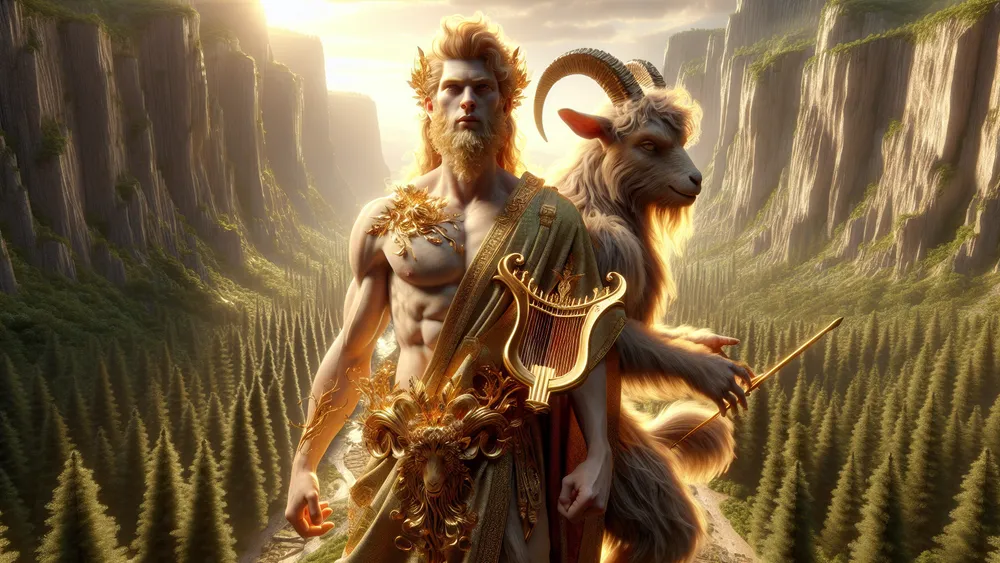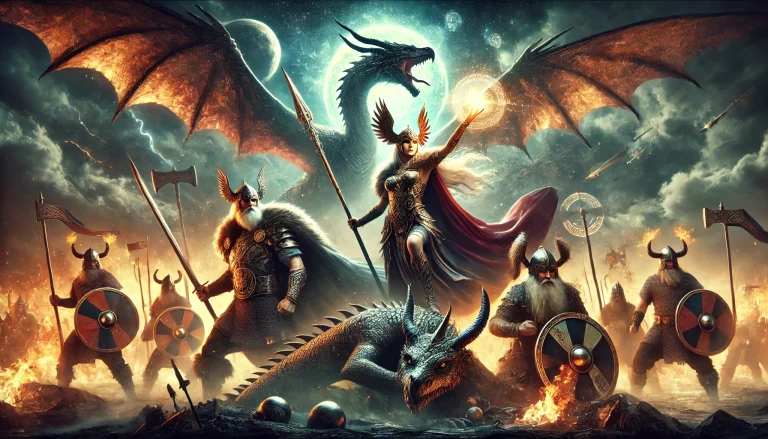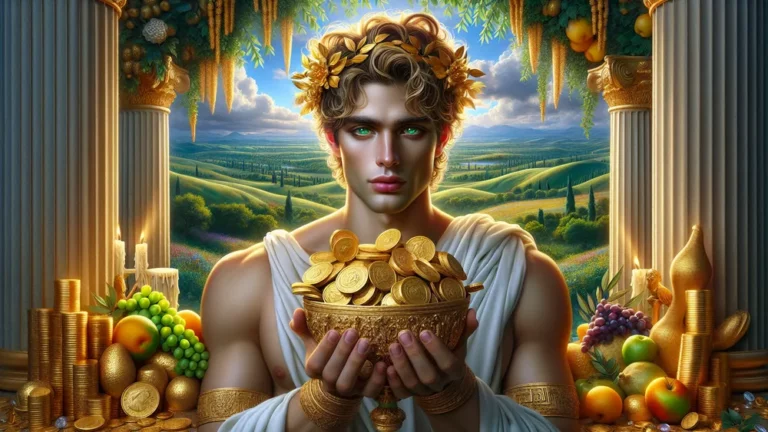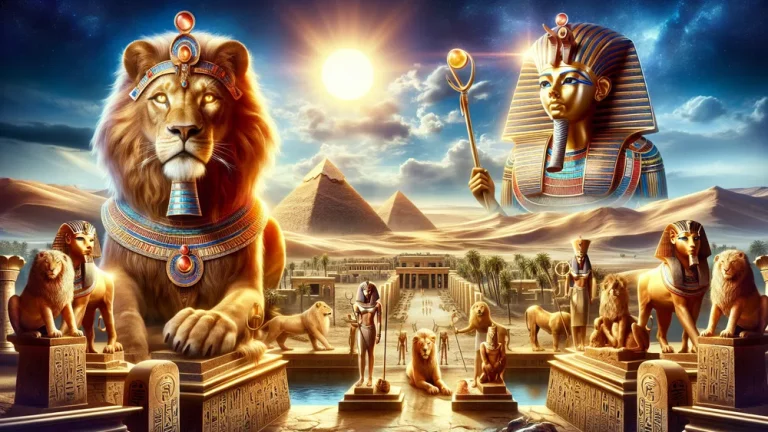Mousika-Musica: Greek Origins Of Music And The Arts
For the ancient Greeks, music and the arts weren’t just ways to entertain themselves. They saw these fields as crucial parts of how they lived, what they believed, and even how they practiced religion.
Key Points:
- Mousika combined creativity, intellect, and spirituality, going beyond today’s idea of music.
- It was seen as a gift from gods, especially Apollo and the Nine Muses, and linked human effort to divine wisdom.
- The Nine Muses inspired different arts, like epic poetry, music, dance, and even astronomy.
- Apollo symbolized harmony and order and acted as the god of Mousika and a guide for creativity.
- Mousika played a big role in Greek rituals, festivals, and education, helping shape character and shared culture.
- Instruments like the lyre, aulos, and kithara carried deep meaning, connecting music to myths and values.
- Myths and pottery highlighted Mousika as a sacred art tied to balance, creativity, and moral lessons.
All of these areas, which they grouped under the name Mousika, were thought of as gifts from gods called The Muses. These beings were linked to creative efforts like dance, poetry, and astronomy, areas where they thought knowledge and creativity connected. To them, Mousika wasn’t the same thing we mean when we say “music” today.
It stretched far beyond that to cover anything they thought of as creative, intellectual, or artistic. What it ultimately meant was finding a balance that put together feelings, thinking, and what they saw as divine order. Because of this, they felt that working in these areas wasn’t just about getting technically better; it was about improving yourself as a person, thinking clearly, and strengthening your values.
You could find Mousika showing up everywhere, whether it was in the epic words of Homer or the songs they sang during religious ceremonies at temples. What that meant to them was a connection to the universe and ideals they thought were higher than human experience.
We can trace the idea of Mousika back to their cultural habits, myths, and stories, ranging from the important role of the Nine Muses to the influence of Apollo, a god tied closely to music and order.
Mousika-Musica: Overview and Key Facts
| Key Aspect | Details |
|---|---|
| Origin of the Term | The word Mousika comes from the Greek term “mousikos.” It means “connected to the Muses,” who were goddesses of creativity in both art and knowledge. |
| Core Meaning | Mousika wasn’t just music. It was a way to combine art, thinking, and spirituality into one idea that balanced life itself with harmony. |
| Philosophical Foundation | For the Greeks, it expressed what they valued: keeping their thoughts and feelings in balance while relating art to morality and the greater universe. |
| Connection to the Divine | People looked at Mousika as a gift from gods like Apollo or the Nine Muses. They thought of it as something sacred that connected wisdom with spirituality. |
| Scope of Mousika | Mousika included more than music. It blended together things like poetry, dance, acting, and even math, revealing how these were part of one idea. |
| Key Figures | Important mythical figures connected with Mousika were Apollo, a god of balance and music, and the Nine Muses, who inspired areas of learning and art. |
| Cultural Importance | Mousika had many roles: in rituals, in teaching, and during festivals. It helped people feel united, proud, and focused on building good character. |
| Symbolism | Through Mousika, the Greeks believed life could be ordered, not chaotic. They saw it as something needed for a disciplined and morally focused way of living. |
Getting to Know Mousika-Musica: How the Greeks Looked at Music and the Arts
To get a better idea of what Mousika was, it helps to look at where it came from, how it was tied to ideas about gods like the Muses, and why it was part of how people lived their lives in Greece. As for Mousika’s importance, it wasn’t just about music itself – it brought together different ideas and connected them to everyday Greek life.
What’s next is learning more about its many parts and why it mattered so much in their culture.
Where Did the Word Mousika Come From, and How Does It Tie to the Muses?
The word Mousika comes from a Greek term, “mousikos,” which means something connected to the Muses. These Muses, in Greek mythology, were daughters of Zeus and Mnemosyne (or Memory). People believed that they stood for ideas related to art, learning, and creative expression. As for Mousika, it wasn’t only about what we today call music. Instead, it included several things – poetry, dance, and even scientific thinking.
The Greeks thought of Mousika as something that combined sharp intellectual thinking with deeper emotional meaning. It acted as a kind of link – between people and what they saw as divine truths. In ancient times, performers and poets often asked the Muses for help when it came to inspiration.
That idea of the Muses being a source of all human creativity and ideas helped make Mousika more than just an art or a field – it became a way to connect the world of people and the gods they believed in.

Each one of the Nine Muses had their own area of focus, so Mousika touched several parts of life. Below are those Muses and what they were associated with:
- Calliope: Epic poetry, focusing on important hero stories.
- Clio: History, looking at the past to understand it better.
- Erato: Love poetry, focusing on emotions and passion.
- Euterpe: Music and lyric poetry, standing for harmony.
- Melpomene: Tragedy, which drew out strong feelings.
- Polyhymnia: Sacred hymns, connecting faith with art.
- Terpsichore: Dance, focusing on movement and rhythm.
- Thalia: Comedy and light poetry, offering amusement.
- Urania: Astronomy, connecting the heavens with thought.
From the grand storytelling inspired by Calliope to the study of stars guided by Urania, all the Muses together represented how intellect, emotion, and creativity worked as one. Because of that, Mousika was much more than art – it was a way of life and thought that tied people to the gods.
Mousika in ancient Greece blended art, learning, and creativity, connecting human intellect and emotions with divine inspiration through the guidance of the Muses.
Who Were the Nine Muses, and What Did They Represent?
In Greek mythology, the Nine Muses were thought of as more than just gods. They were seen as central figures that supported human creativity and helped people with learning. Zeus, the king of all gods, and Mnemosyne, who represented memory, were seen as their parents. People believed that this connection between memory and divinity explained how creativity came into existence.
Each Muse was linked to a specific part of creative or emotional work, helping bring balance to these different areas. For instance, Calliope was said to help poets write about heroes and their legendary deeds. As for Euterpe, she was connected to music and was important for people who played instruments or made songs.
In addition, others, like Terpsichore, were tied to dance, which was thought to represent movement and joy. What each Muse did connected to Mousika as a whole, which was bigger than music alone. It included writing stories, singing songs, creating dramas, performing dances, and even thinking about the sciences. The Greeks saw them as necessary for any kind of creativity.
When people needed guidance in their creative work, they looked to the Muses for help. This often happened during festivals, rituals, and other large gatherings, where hymns were sung, and gods were praised. By doing this, people believed they could connect their creative work to higher, divine excellence.
Together, the Muses represented different talents and ideas – but all of them were seen as working together toward the same purpose: making creativity better by linking human effort with divine wisdom.
How Was Apollo the Guiding Force Behind Mousika?
Apollo was connected to many things, including light, prophecy, and healing. But for the Greeks, he was also seen as the god of music and harmony in the universe. Because of this, people called him “leader of the Muses” or Musagetes.
He stood for the controlled and disciplined way of looking at art and music, which reflected order and balance within the cosmos itself. One key part of his mythology was the lyre, which was said to have been created by Hermes and later given to him. This instrument represented how Apollo could bring music to its most perfect form, something people strived for.
To many, he was not only a musician but also the highest example of artistic greatness. He connected creative work by mortals to the goals of the gods, making him someone people looked up to when they wanted their work to follow higher principles. He was often seen as the reason why the arts went beyond entertainment and became something linked to morality, balance, and Mousika’s larger philosophy.
Apollo’s influence did not stop with what he represented. He played an active role in helping others. For example, the myth of Orpheus tells us how Apollo guided the young musician, helping him develop skills that could touch the hearts of both humans and gods with the sound of his lyre.
At festivals like the Pythian Games, which were held at Delphi, people celebrated music and the arts in ways they believed honored him. These events included competitions where musicians and poets performed to inspire pride in their cities and show respect for the gods.
With his unique role as both someone who created harmony and ensured it stayed intact, Apollo was central to the idea of Mousika. In this way, art and deep thinking, when handled carefully, helped people understand what they believed to be the rhythms of the universe itself.
How Did Mousika Shape Everyday Life in Ancient Greece?
Mousika was a key part of religious life in ancient Greece. It combined art, music, and spiritual practices in rituals and ceremonies. People often sang hymns called paeans to honor the gods. These hymns were played along with instruments like the lyre or the aulos. For example, temples for Apollo, who was the god of Mousika, often echoed with melodic chants.
These chants were believed to reflect his role in keeping universal harmony. Festivals, such as the Dionysia, also included Mousika. During these events, people performed music and dances to honor Dionysus, expressing shared emotions and paying respect. People thought that invoking the Muses through songs or poetry would make their ceremonies more sacred and successful. In education, Mousika played an essential role.
Greek teaching used music as part of shaping good citizens. Boys were taught to play the lyre and to memorize poetry, which was seen as essential for cultural and moral education, or what the Greeks called paideia. Musical training taught them values like balance and self-control, which were important in life. At the same time, Mousika had a big presence in public festivals.
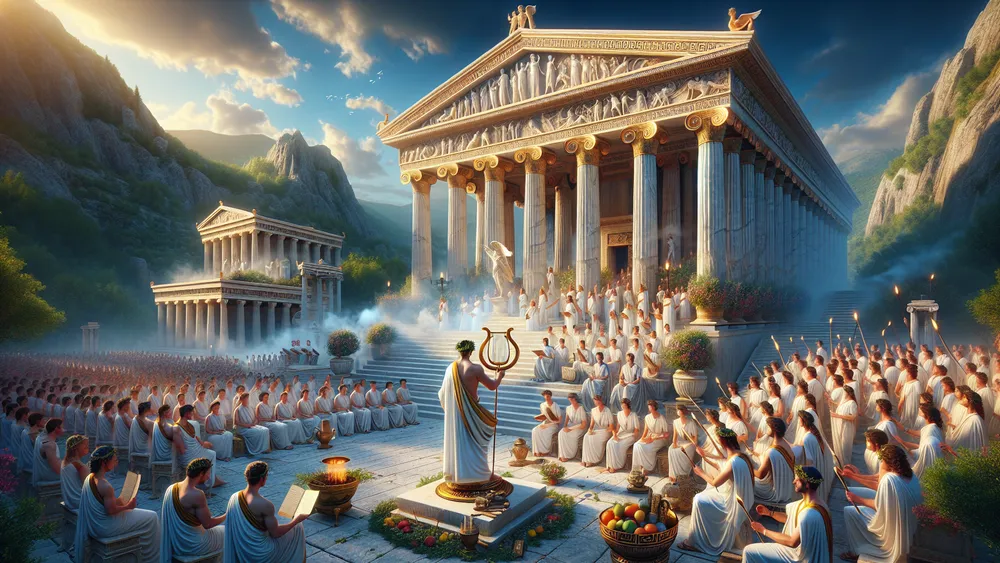
Events like the Panathenaia in Athens or the Pythian Games in Delphi brought communities together with musical contests, dramatic plays, and dances. By celebrating the gods through art, Greeks also felt connected with their cities and their culture. In many ways, these festivals highlighted Mousika’s ability to unite people, proving how essential it was to both everyday life and communal pride.
Legendary Musical Showdowns in Greek Mythology
The story of Apollo and Marsyas is one of the most famous warning stories in Greek mythology. It shows the danger of being overly confident and the undeniable greatness of divine Mousika. The myth explains that Marsyas, a satyr, found the aulos, a double-reed instrument, after it was thrown away by Athena. Marsyas learned how to play it and became so skilled that he believed his music could match Apollo’s.
He challenged Apollo to a contest. They decided that the winner could punish the loser in any way they wanted. During the contest, both performers impressed their listeners. Marsyas played with energy and passion on the aulos, and his music was lively and wild. Apollo, on the other hand, used his lyre to perform music that sounded more refined and harmonious. In the end, Apollo won.
He achieved this by playing the lyre while also singing, something Marsyas could not copy. As his penalty, Marsyas was flayed alive by Apollo, a punishment that reminded people of the consequences of disrespecting gods or trying to rival their skill. Even though some versions of the myth differ, the main idea is the same: Mousika was considered a sacred art that mortals could admire but never surpass.
Another story tells of a contest between Apollo and Pan, the god of rustic music. Pan played the syrinx, or reed pipes, and created natural tunes that were wild and untamed, fitting for the countryside. Confident in his music, Pan decided to test his abilities against Apollo, who represented structured and rational music.
Tmolus, who was said to be the spirit of a mountain, was chosen to judge the competition. He praised Apollo’s music, which was precise and balanced. Pan’s music, although energetic and raw, was seen as less polished and lacking in composure. In this myth, King Midas also appears. He preferred Pan’s wild music over Apollo’s.
For his poor judgment, Apollo gave him donkey ears to show his failure to understand true artistry. What these myths suggest is that while creativity and freedom in music (which Pan symbolized) had value, true Mousika required harmony, order, and connection to higher ideals, all of which Apollo stood for. These stories demonstrate how important Mousika was in ancient Greek culture.

Marsyas’s suffering taught mortals to respect the gods’ authority, and Pan’s loss emphasized the need for music to reflect balance and universal order. Together, they show that Mousika was more than just entertainment – it was a way to connect to something greater and follow the patterns of the cosmos itself.
The myths of Apollo and Marsyas, as well as Apollo and Pan, highlight the need to respect divine authority and the belief that true music embodies order, harmony, and higher ideals.
Painting a Picture of Mousika: How Music and Arts Showed Up in Greek Pottery
The ancient Greeks used pottery to record their understanding of Mousika. On their pots, they drew detailed pictures that combined their ideas of art, culture, and daily life. These designs helped capture how important music and art were to them. By decorating pottery with such care, they made everyday objects meaningful. The pictures they painted help us see how strongly the arts connected to their beliefs.
Even tools they used daily carried designs that reflected their culture. Through this, we learn how much value art and music had in shaping their world.
Stories and Scenes of Mousika on Ancient Pottery
Ancient Greek pottery works as a collection of images that keeps the stories of Mousika alive. On these objects, artists included detailed pictures that showed Apollo with his lyre, the Nine Muses practicing music and poetry, and even people taking part in rituals and contests with music or dancing. But these weren’t just decorations. These images also helped people understand the importance of Mousika in their culture and religion.
Pottery also helped focus attention on important instruments in Mousika. The lyre, often held by Apollo or other skilled musicians, and the aulos, which was linked to celebrations for Dionysus, were especially common in these pictures. Artists made pottery using two different methods. In the older Black-Figure style, they painted black images on red clay.
Later, they switched to the Red-Figure method, which reversed the colors. This change let them draw details much better. These objects, which could be anything from cups for drinking to kraters used to mix wine, served another role. For people in their homes, they acted like storybooks, preserving gods, instruments, and the people who practiced Mousika.
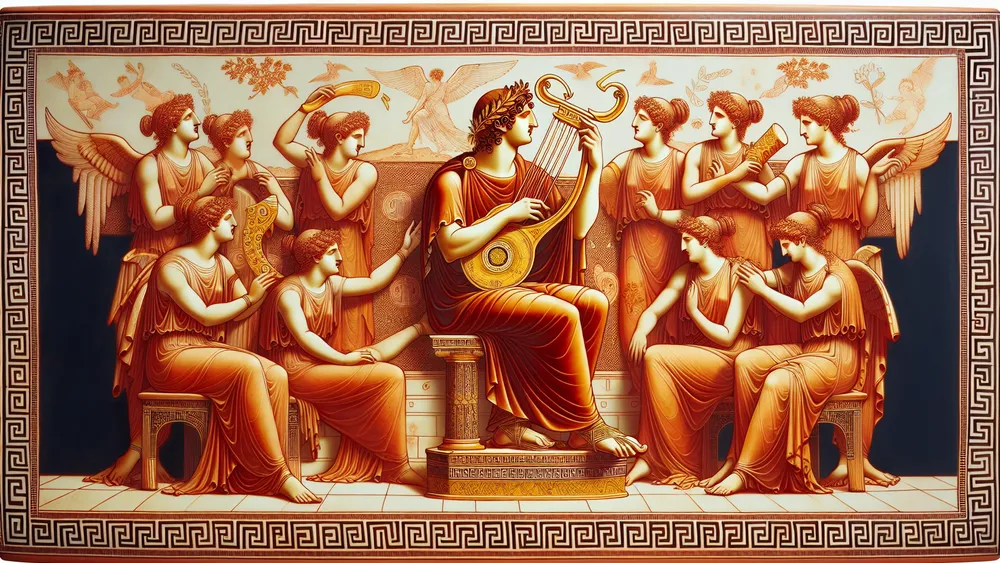
| Scene | Instrument(s) Seen | Pottery Type |
|---|---|---|
| Apollo with the lyre | Lyre | Red-Figure |
| The Nine Muses | Lyre, Kithara, Aulos | Black-Figure |
| Dionysian revelry | Aulos | Red-Figure |
| Music competition scenes | Lyre, Kithara | Black-Figure |
The Instruments That Brought Mousika to Life
On painted pottery and in the myths told by the ancient Greeks, the instruments of Mousika were central to both their art and their culture. These instruments gave shape to the way they expressed themselves in music, rituals, and storytelling. In these objects and stories, instruments tied to the gods stood out for their importance.
They are still a way for people today to understand the music of a time long gone.
The Lyre’s Mythical Origin and Its Deep Meaning
In Greek myths, Hermes, the clever god of trade and trickery, is said to have come up with the lyre shortly after he was born. He killed a tortoise and made the lyre’s body out of its empty shell, using reeds and strings to give it a unique sound. After stealing Apollo’s cattle, Hermes used the lyre as a way to settle things. Apollo, angry about the theft, confronted Hermes.
To calm him, Hermes gave him the lyre as a gift. Apollo liked the way it looked and sounded, so he accepted it. This exchange led to the lyre being tied to Apollo as one of his key symbols. People from that point on also connected it with Mousika, meaning art, wisdom, and balance in life.
The story stayed mostly the same in different parts of Greece, although there were some small changes. In some versions, the materials Hermes used to build the lyre or the exact words spoken between him and Apollo might be a little different. These changes show how myths evolved as they were passed on. Outside of myths, the lyre was very important for Greek culture.
It wasn’t just a tool for music but was also seen as a symbol of discipline and learning, which were key ideas in Mousika. People believed the sound of the lyre meant more than just music – it was connected to the overall order of the universe. For the Greeks, learning to play it was part of growing up and becoming educated.
It helped people understand reason and order, making it opposite in meaning to the aulos, an instrument linked with wild emotions and Dionysian celebrations. In this way, the lyre became a symbol of harmony, creativity, and structure in Greek life, joining the worlds of gods and humans.
Other Instruments of Mousika: The Aulos and the Kithara
The aulos, which was a wind instrument with two reeds, played a big part in ancient Greek music. People connected it closely to Dionysus, the god of wine, theater, and celebration. Its sharp and energetic sound was meant to create strong feelings, making it perfect for big group gatherings.
The instrument, with its two pipes often played at the same time, made music that felt wild and full of energy, bringing out emotions without restraint. People often played it during Dionysian festivals like the Dionysia, when dances and rituals filled the streets. It brought everyone together, creating a feeling of shared excitement.
But the aulos was also part of cultural debates. Some people thought it didn’t belong in formal education because its energy didn’t fit with Apollo’s structured ways, and this made it very different from the lyre or the kithara. The kithara, unlike the aulos, was made for professionals who knew their craft well.
A large stringed instrument with seven or more strings, it was made with a wooden base that gave it a clear, steady sound. Players usually plucked it with a tool called a plectrum. People connected it deeply to Apollo because it stood for skill and thoughtfulness. It was used for competitions, like those at the Pythian Games in Delphi, and for big ceremonies.
The Pantheon of Greek Abstract and Natural Forces
In Greek mythology, there were many gods beyond the ones most people know, like Zeus or Athena. These gods represented things that were part of everyday life – such as feelings or forces in nature – that the Greeks wanted to understand or explain. Some figures stood for emotions, like Eros, who represented love, or Eris, who symbolized conflict.
Others were connected to the natural world, like Nyx for night or Helios, who stood for the sun. These gods were seen as important, just like the Olympians, and many people relied on them to make sense of the world around them. Through these deities, the Greeks could connect their beliefs to specific parts of life, whether it was about human feelings or the things they saw in nature every day.
Their importance helped shape how religion and beliefs worked for ancient Greek culture. If you want to learn more about these gods and their roles, you can explore a full list with all Greek Abstract and Natural Forces and see how they shaped ancient life.
FAQs
What philosophies underlie the concept of Mousika?
The philosophies underlying the concept of Mousika emphasize the Greek ideal of harmonizing intellect, emotion, and cosmic order to cultivate the soul.
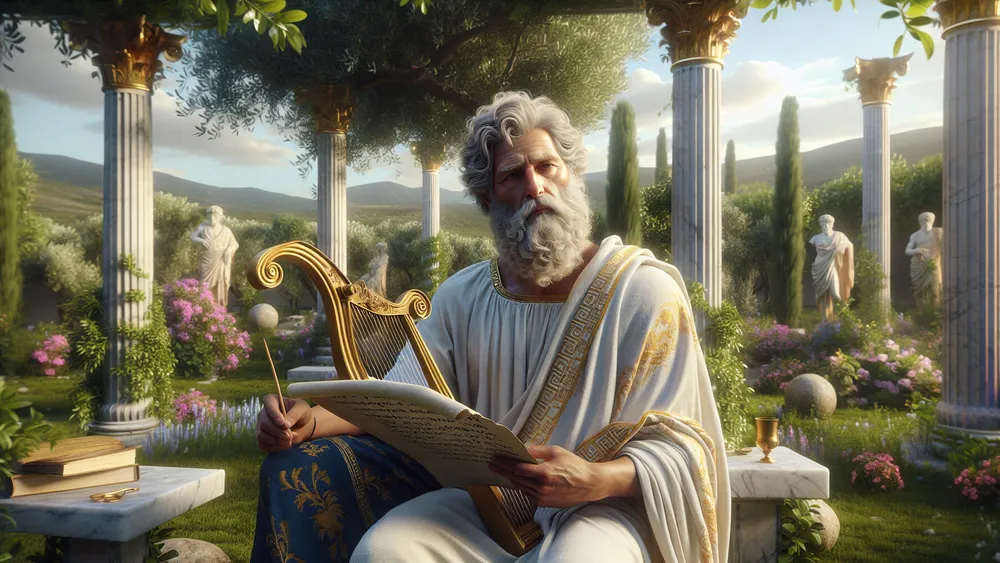
How did Mousika influence Greek festivals?
Mousika influenced Greek festivals by serving as a unifying force through performances of music, poetry, and dance that honored the gods and reinforced communal harmony.
Why was Mousika central to Greek philosophical thought?
Mousika was central to Greek philosophical thought because it embodied the harmonious integration of intellect, emotion, and moral order essential to the cultivation of the soul.
How does Mousika reflect morality in Greek myths?
Mousika reflects morality in Greek myths by illustrating divine justice and the consequences of hubris, as seen in tales like Apollo versus Marsyas.
